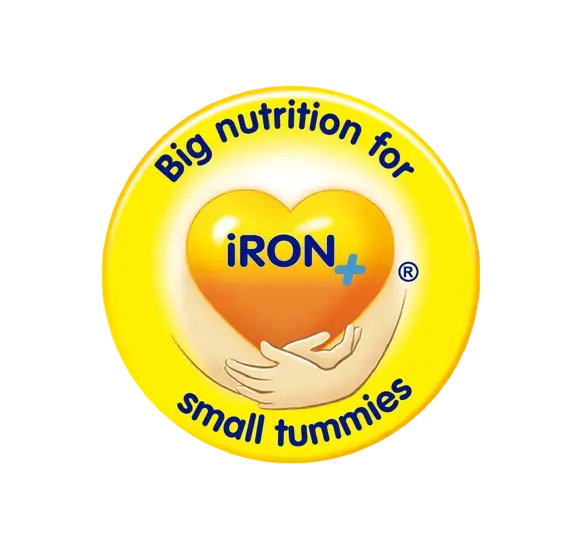The right nutrition for growing kids

Cerelac® - Full of the goodness of multigrains to meet the nutritional needs of growing children
Young children use their bodies to communicate, learn and grow.1 This means that even though their bodies are small, their energy needs are high.2 They need nutrient-dense food, packed with protein, vitamins and minerals.3
Cerelac® provides wholesome nutrition with multicereals.

Iron+
The iron+ bundle in Cerelac® provides energy, increases stamina and supports brain development.4–8
Iron is particularly important for reducing the risk of childhood anemia and supporting cognitive development during this vital stage of growth.9,10

The goodness of multigrains
Cerelac® contains the natural grains wheat, oat, corn, barley, and rice. These grains provide nutritional support for children as they grow. Wheat, oat and barley improve cognitive function, digestive health and immunity; they also promote a healthy gut microbiota.13–16 Rice is a source of magnesium, which supports the function of the developing nervous system.17,18 Corn is rich in vitamin C, which enhances iron absorption, increasing its bioavailability.19

Probiotics, zinc and added vitamins
The probiotic Bifidus BL in Cerelac® kids’ cereals helps to support immunity,20 protecting against respiratory infections and diarrheal illnesses.21,22 These cereals also contain several immunonutrients – zinc, vitamin C and vitamin A - which modulate and maintain the immune system, reducing the risk of infection.23–25
References:
1. American Academy of Pediatrics. Nutrition & Fitness - HealthyChildren.org. Accessed October 14, 2021. https://www.healthychildren.org/English/ages-stages/preschool/nutrition…
2. Food and Agriculture Administraion. Energy and protein requirements: Infants, Children and Adolescents. Accessed October 14, 2021. https://www.fao.org/3/aa040e/aa040e07.htm
3. British Nutrition Foundation. A healthy, varied diet for children - British Nutrition Foundation. Accessed October 14, 2021. https://www.nutrition.org.uk/life-stages/children/a-healthy-varied-diet…
4. B L, MK G. Iron deficiency and brain development. Semin Pediatr Neurol. 2006;13(3):158-165. doi:10.1016/J.SPEN.2006.08.004
5. Scientific Opinion on the substantiation of a health claim related to iodine and contribution to normal cognitive development pursuant to Article 14 of Regulation (EC) No 1924/2006. EFSA J. 2014;12(1). doi:10.2903/J.EFSA.2014.3517
6. Scientific Opinion on the substantiation of a health claim related to thiamin and maintenance of normal neurological development and function pursuant to Article 14 of Regulation (EC) No 1924/2006. EFSA J. 2011;9(2). doi:10.2903/J.EFSA.2011.1980
7. Scientific Opinion on the substantiation of a health claim related to alpha linolenic acid and contribution to brain and nerve tissue development pursuant to Article 14 of Regulation (EC) No 1924/2006. EFSA J. 2011;9(4). doi:10.2903/J.EFSA.2011.2130
8. DeMaeyer EM, Joint WHO/UNICEF Nutrition Support Programme. Preventing and controlling iron deficiency anaemia through primary health care : a guide for health administrators and programme managers. Published online 1989:58.
9. World Health Organization. WHO guidance helps detect iron deficiency and protect brain development. Published 2020. Accessed October 12, 2021. https://www.who.int/news/item/20-04-2020-who-guidance-helps-detect-iron…
10. Eichler K, Wieser S, Rüthemann I, Brügger U. Effects of micronutrient fortified milk and cereal food for infants and children: a systematic review. BMC Public Heal 2012 121. 2012;12(1):1-13. doi:10.1186/1471-2458-12-506
11. Nestle. Data on File.
12. World Health Organization. Guideline: Sugars Intake for Adults and Children.; 2015. Accessed October 14, 2021. https://www.who.int/publications/i/item/9789241549028
13. Lozoff B, Beard J, Connor J, Felt B, Georgieff M, Schallert T. Long-lasting neural and behavioral effects of iron deficiency in infancy. Nutr Rev. 2006;64(5 SUPPL. 1). doi:10.1301/nr.2006.may.S34-S43
14. Kennedy DO. B vitamins and the brain: Mechanisms, dose and efficacy—A review. Nutrients. 2016;8(2). doi:10.3390/nu8020068
15. Costabile A, Klinder A, Fava F, et al. Whole-grain wheat breakfast cereal has a prebiotic effect on the human gut microbiota: A double-blind, placebo-controlled, crossover study. Br J Nutr. 2008;99(1):110-120. doi:10.1017/S0007114507793923
16. El Khoury D, Cuda C, Luhovyy BL, Anderson GH. Beta glucan: health benefits in obesity and metabolic syndrome. J Nutr Metab. 2012;2012:851362. doi:10.1155/2012/851362
17. de Baaij JHF, Hoenderop JGJ, Bindels RJM. Magnesium in man: Implications for health and disease. Physiol Rev. 2015;95(1):1-46. doi:10.1152/physrev.00012.2014
18. Kirkland AE, Sarlo GL, Holton KF. The role of magnesium in neurological disorders. Nutrients. 2018;10(6). doi:10.3390/nu10060730
19. Cook JD, Monsen ER. Vitamin C, the common cold, and iron absorption. Am J Clin Nutr. 1977;30(2):235-241. doi:10.1093/ajcn/30.2.235
20. Jungersen M, Wind A, Johansen E, Christensen JE, Stuer-Lauridsen B, Eskesen D. The science behind the probiotic strain bifidobacterium animalis subsp. Lactis bb-12®. Microorganisms. 2014;2(2):92-110. doi:10.3390/microorganisms2020092
21. Taipale T, Pienihkkinen K, Isolauri E, et al. Bifidobacterium animalis subsp. lactis BB-12 in reducing the risk of infections in infancy. Br J Nutr. 2011;105(3):409-416. doi:10.1017/S0007114510003685
22. Chouraqui JP, Van Egroo LD, Fichot MC. Acidified Milk Formula Supplemented With Bifidobacterium lactis: Impact on Infant Diarrhea in Residential Care Settings. J Pediatr Gastroenterol Nutr. 2004;38(3):288-292. doi:10.1097/00005176-200403000-00011
23. Wintergerst ES, Maggini S, Hornig DH. Immune-enhancing role of Vitamin C and zinc and effect on clinical conditions. Ann Nutr Metab. 2006;50(2):85-94. doi:10.1159/000090495
24. Huang Z, Liu Y, Qi G, Brand D, Zheng SG. Role of vitamin A in the immune system. J Clin Med. 2018;7(9). doi:10.3390/jcm7090258
25. Gombart AF, Pierre A, Maggini S. A Review of Micronutrients and the Immune System–Working in Harmony to Reduce the Risk of Infection. Nutr 2020, Vol 12, Page 236. 2020;12(1):236. doi:10.3390/NU12010236